Abstract
The dominant C57BL/10 allele of a single autosomal, non-H-2 gene (Rfv-3) was found to be required for recovery from viremia and leukemia induced by Friend virus complex in H-2b/b mice. In H-2a/a mice, the Rfv-3 gene apparently influenced recovery from viremia in the presence of persistent leukemia because these mice lacked the appropriate H-2 genotype for recovery from leukemia. The Rfv-3 gene was distinct from the Fv-2 gene because recovery from viremia was seen in recombinant-inbred mice with the Fv-2s/s genotype. Furthermore, backcross studies indicated that Rfv-3 and Fv-2 were not linked. The Rfv-3 gene may act by influencing the specific anti-FV humoral antibody response.
Full text
PDF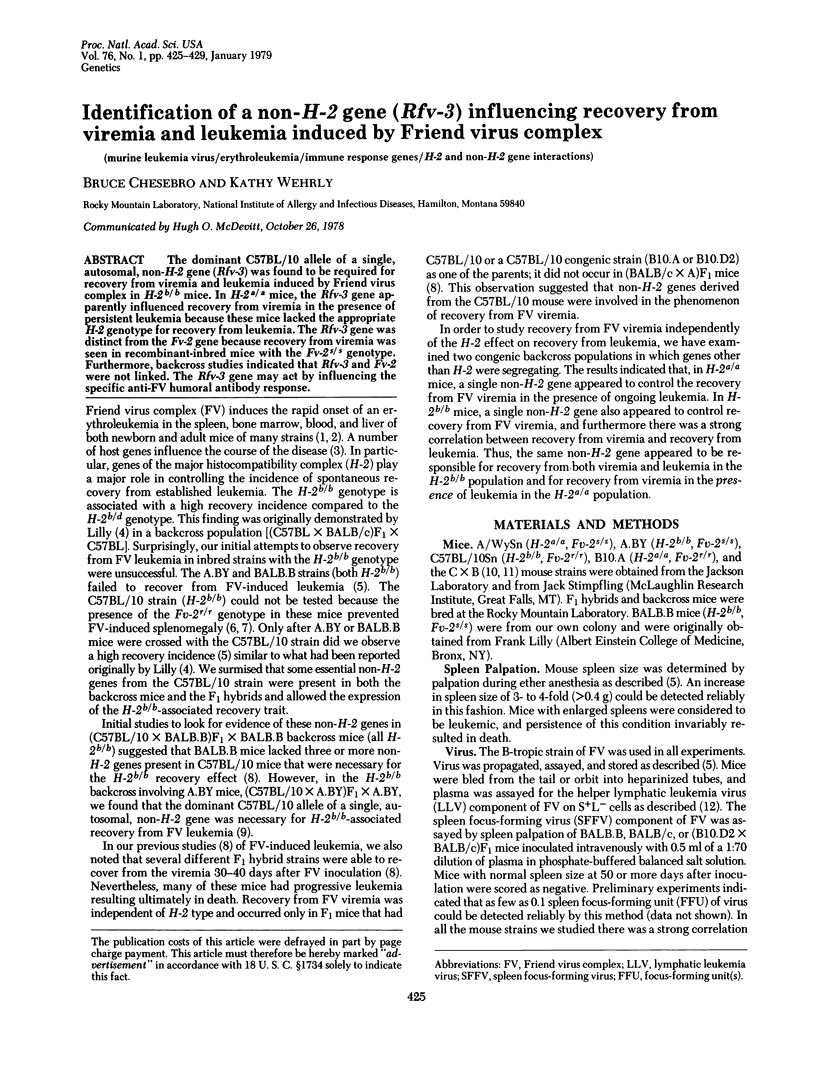
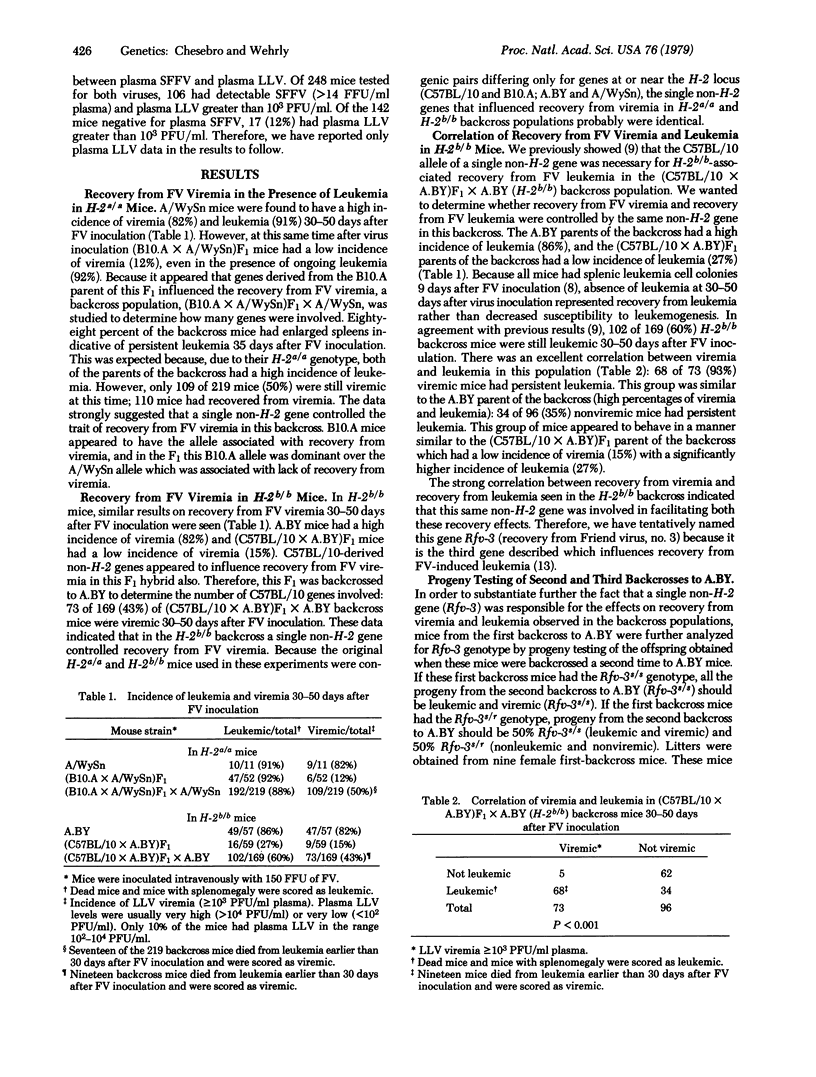
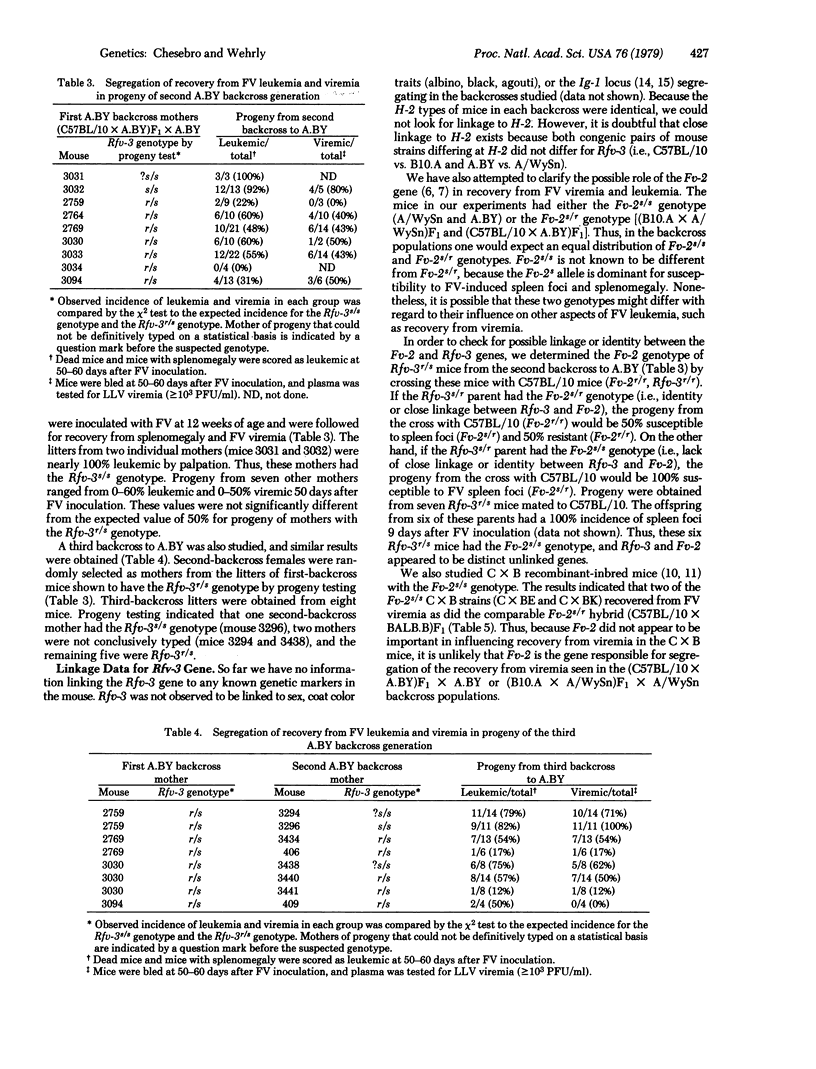
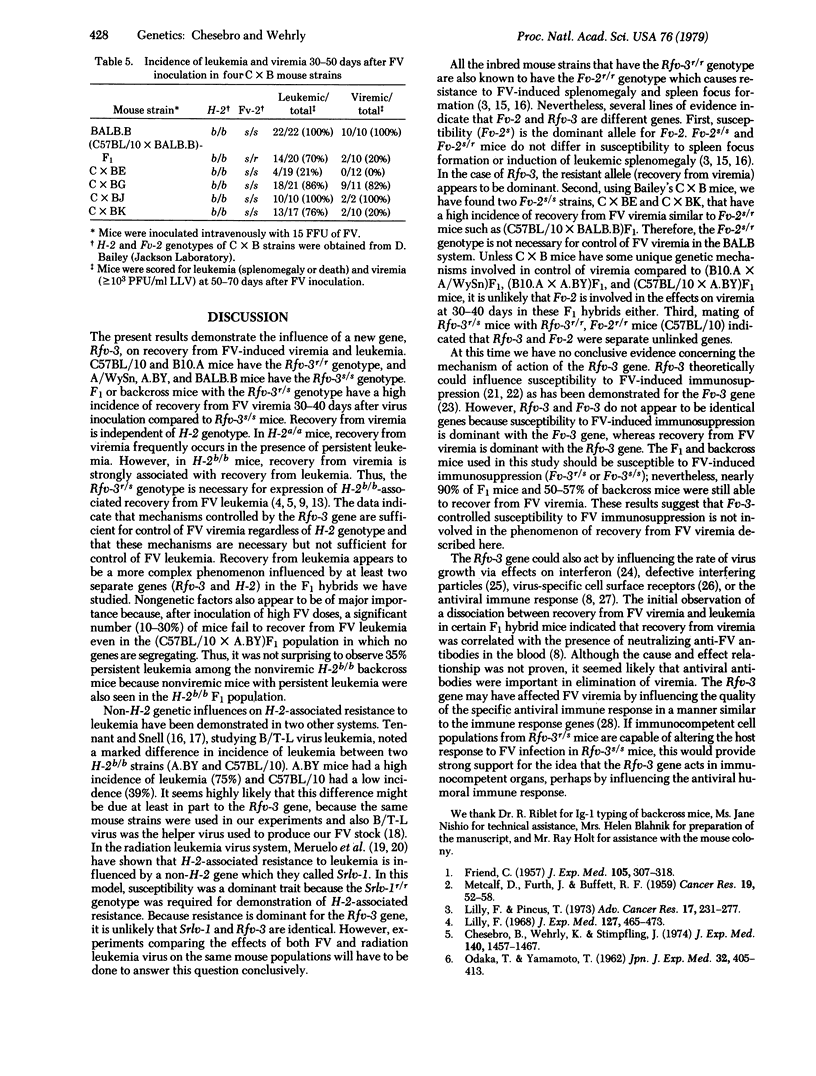
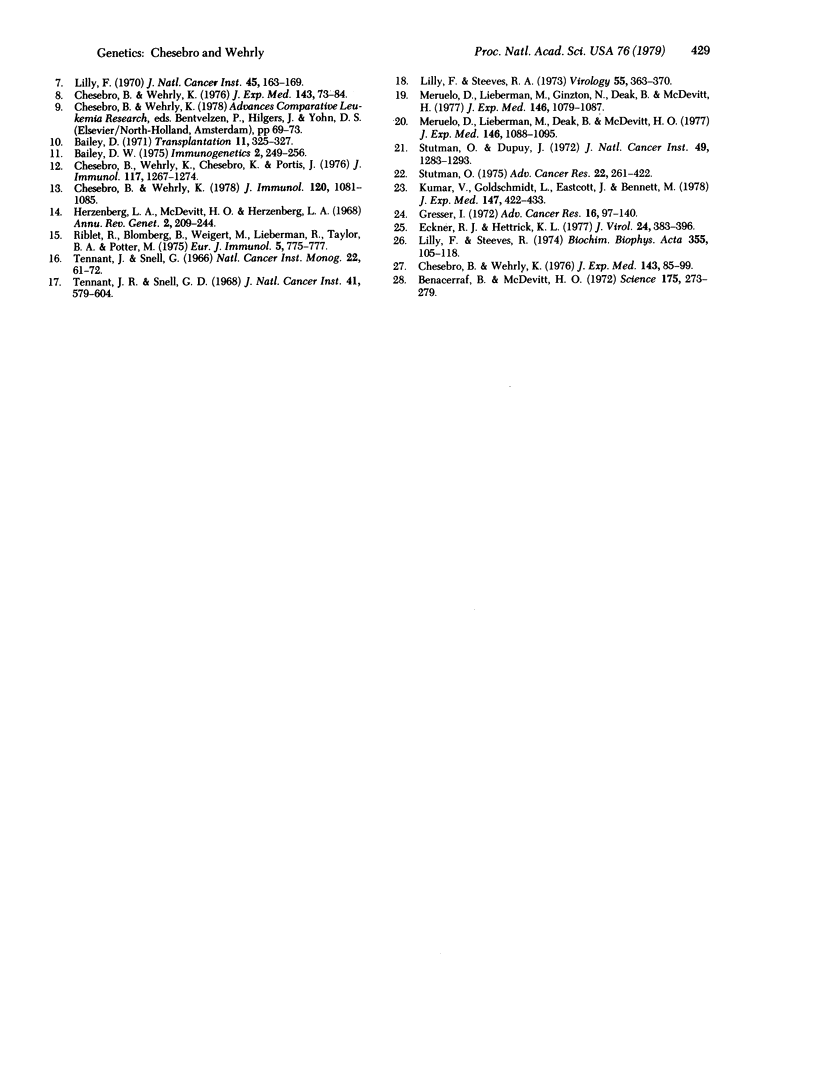
Selected References
These references are in PubMed. This may not be the complete list of references from this article.
- Bailey D. W. Recombinant-inbred strains. An aid to finding identity, linkage, and function of histocompatibility and other genes. Transplantation. 1971 Mar;11(3):325–327. doi: 10.1097/00007890-197103000-00013. [DOI] [PubMed] [Google Scholar]
- Benacerraf B., McDevitt H. O. Histocompatibility-linked immune response genes. Science. 1972 Jan 21;175(4019):273–279. doi: 10.1126/science.175.4019.273. [DOI] [PubMed] [Google Scholar]
- Chesebro B., Wehrly K., Chesebro K., Portis J. Characterization of Ia8 antigen, thy-1.2 antigen, complement receptors, and virus production in a group of murine virus-induced leukemia cell lines. J Immunol. 1976 Oct;117(4):1267–1274. [PubMed] [Google Scholar]
- Chesebro B., Wehrly K. Rfv-1 and Rfv-2, two H-2-associated genes that influence recovery from Friend leukemia virus-induced splenomegaly. J Immunol. 1978 Apr;120(4):1081–1085. [PubMed] [Google Scholar]
- Chesebro B., Wehrly K., Stimpfling J. Host genetic control of recovery from Friend leukemia virus-induced splenomegaly: mapping of a gene within the major histocompatability complex. J Exp Med. 1974 Dec 1;140(6):1457–1467. doi: 10.1084/jem.140.6.1457. [DOI] [PMC free article] [PubMed] [Google Scholar]
- Chesebro B., Wehrly K. Studies on the role of the host immune response in recovery from Friend virus leukemia. I. Antiviral and antileukemia cell antibodies. J Exp Med. 1976 Jan 1;143(1):73–84. doi: 10.1084/jem.143.1.73. [DOI] [PMC free article] [PubMed] [Google Scholar]
- Chesebro B., Wehrly K. Studies on the role of the host immune response in recovery from Friend virus leukemia. II. Cell-mediated immunity. J Exp Med. 1976 Jan 1;143(1):85–99. doi: 10.1084/jem.143.1.85. [DOI] [PMC free article] [PubMed] [Google Scholar]
- Eckner R. J., Hettrick K. L. Defective Friend spleen focus-forming virus: interfering properties and isolation free from standard leukemia-inducing helper virus. J Virol. 1977 Oct;24(1):383–396. doi: 10.1128/jvi.24.1.383-396.1977. [DOI] [PMC free article] [PubMed] [Google Scholar]
- FRIEND C. Cell-free transmission in adult Swiss mice of a disease having the character of a leukemia. J Exp Med. 1957 Apr 1;105(4):307–318. doi: 10.1084/jem.105.4.307. [DOI] [PMC free article] [PubMed] [Google Scholar]
- Gresser I. Antitumor effects of interferon. Adv Cancer Res. 1972;16:97–140. doi: 10.1016/s0065-230x(08)60339-5. [DOI] [PubMed] [Google Scholar]
- Kumar V., Goldschmidt L., Eastcott J. W., Bennett M. Mechanisms of genetic resistance to Friend virus leukemia in mice. IV. Identification of a gene (Fv-3) regulating immunosuppression in vitro, and its distinction from Fv-2 and genes regulating marrow allograft reactivity. J Exp Med. 1978 Feb 1;147(2):422–433. doi: 10.1084/jem.147.2.422. [DOI] [PMC free article] [PubMed] [Google Scholar]
- Lilly F. Fv-2: identification and location of a second gene governing the spleen focus response to Friend leukemia virus in mice. J Natl Cancer Inst. 1970 Jul;45(1):163–169. [PubMed] [Google Scholar]
- Lilly F., Steeves R. A. B-tropic Friend virus: a host-range pseudotype of spleen focus-forming virus (SFFV). Virology. 1973 Oct;55(2):363–370. doi: 10.1016/0042-6822(73)90176-1. [DOI] [PubMed] [Google Scholar]
- Lilly F., Steeves R. Antigens of murine leukemia viruses. Biochim Biophys Acta. 1974 Apr 29;355(1):105–118. doi: 10.1016/0304-419x(74)90009-2. [DOI] [PubMed] [Google Scholar]
- Lilly F. The effect of histocompatibility-2 type on response to friend leukemia virus in mice. J Exp Med. 1968 Mar 1;127(3):465–473. doi: 10.1084/jem.127.3.465. [DOI] [PMC free article] [PubMed] [Google Scholar]
- METCALF D., FURTH J., BUFFETT R. F. Pathogenesis of mouse leukemia caused by Friend virus. Cancer Res. 1959 Jan;19(1):52–58. [PubMed] [Google Scholar]
- Meruelo D., Leiberman M., Ginzton N., Deak B., McDevitt H. O. Genetic control of radiation leukemia virus-induced tumorigenesis. I. Role of the major murine histocompatibility complex, H-2. J Exp Med. 1977 Oct 1;146(4):1079–1087. doi: 10.1084/jem.146.4.1079. [DOI] [PMC free article] [PubMed] [Google Scholar]
- Meruelo D., Lieberman M., Deak B., McDevitt H. O. Genetic control of radiation leukemia virus-induced tumorigenesis II. Influence of Srlv-1, a locus not linked to H-2. J Exp Med. 1977 Oct 1;146(4):1088–1095. doi: 10.1084/jem.146.4.1088. [DOI] [PMC free article] [PubMed] [Google Scholar]
- ODAKA T., EDAKA T., YAMAMOTTO T. Inheritance of susceptibility to Friend mouse leukemia virus. Jpn J Exp Med. 1962 Oct;32:405–413. [PubMed] [Google Scholar]
- Riblet R., Blomberg B., Weigert M., Lieberman R., Taylor B. A., Potter M. Genetics of mouse antibodies. I. Linkage of the dextran response locus, VH-DEX, to allotype. Eur J Immunol. 1975 Nov;5(11):775–777. doi: 10.1002/eji.1830051109. [DOI] [PubMed] [Google Scholar]
- Stutman O., Dupuy J. M. Resistance to Friend leukemia virus in mice: effect of immunosuppression. J Natl Cancer Inst. 1972 Nov;49(5):1283–1293. [PubMed] [Google Scholar]
- Stutman O. Immunodepression and malignancy. Adv Cancer Res. 1975;22:261–422. doi: 10.1016/s0065-230x(08)60179-7. [DOI] [PubMed] [Google Scholar]
- Tennant J. R., Snell G. D. Some experimental evidence for the influence of genetic factors on viral leukemogenesis. Natl Cancer Inst Monogr. 1966 Sep;22:61–72. [PubMed] [Google Scholar]
- Tennant J. R., Snell G. D. The H-2 locus and viral leukemogenesis as studied in congenic strains of mice. J Natl Cancer Inst. 1968 Aug;41(2):597–604. [PubMed] [Google Scholar]


